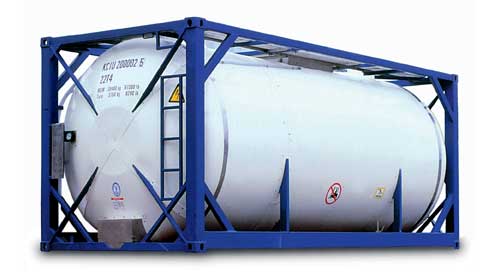An ISO-Tank is a term used to describe a steel “pill shaped” container within a standard ISO (International Standards Organisation) frame which has a type of portable bulk liquid container, used within intermodal transportation when the product itself is not exposed to overflowing during transportation, which makes the whole process faster and more cost-effective. This tank container is used to haul up to 25,000 Litres of bulk liquid, allowing us to transport a higher cargo volume than a standard container can take. The products can range from food-grade products such as orange juice or wine to hazardous chemicals such as hydrochloric acid. An ISO-tank container is considered to be one of the most promising ways of liquid cargos transportation.

What Bulk Liquids are Transported in ISO Tanks?
The bulk liquids that can be transported in an ISO tank include:
- All types of Water
- Hydrogen Peroxide
- Sulphuric Acid
- Nitric Acid
- Mining chemicals
- Food Products
- Solvents
- Oils
- Resins
- Alcoholic Beverages

What are the Advantages of an ISO Tank?
There are plenty of advantages for using an ISO tank. They are a highly reliable, cost effective and safe way of transporting bulk liquids from place to place.
ISO tanks are designed to meet specific criteria according to the substance they will be carrying. Because of this they are very reliable and can withstand extreme pressure and damage. They are highly unlikely to leak, do not require additional packaging materials for the cargo, can maintain a specific temperature for temperature sensitive cargo and they can be transported by road, rail or boat.
Because ISO tanks are built according to the ISO standard, all the valves must be inspected and each tank must have three closures. All three closures must have failed before a leak would happen; making ISO tanks a safer way of transporting bulk liquid than drums and flexi-bags.
What is the dimension of iso tank?
Dimensions: H: 2,591mm x W: 2,438mm x L: 6,058mm
Tare Weight: 3,750 Kg
Max Gross Weight: 36,000 Kg
- Type Approved IMO 1(T11), ADR, RID, TIR
- Electrically Heated / Insulated (optional)
- Discharge 3″ BSP
- Optional Top Discharge
- Airline Connection
- Tank Material SS316L
- 4 bar Working Pressure

Difference between ISO tank and Flexitank
1)The max volume of each flexi-tank is 24 000 liters, so is ISO tank; but, to use flexi-tank means you just need to pay freight for the 20 feet container, which is a big cost-cut compared with ISO tank freight.
2) The supply and distribution of ISO tank is influenced by many factors, which often may have an impact on customers’ plan of import & export, not mention the cost of transfer and loading; it’s too much for customers to bear. While the flexi-tank is free from the influence of supply, distribution, region and environment; what’s more, it takes much less to transfer or load the goods. This is a great favor for customers.
3) The rent for ISO tank is $15/day, and its return and clean may cost $200; while flexi-tank can save these cost.
4) Generally, the ISO tank supply is short and its shipping space is limited; while flexi-tank does not have such problems. It’s in the 20 feet container as ordinary goods in dry container, which can guarantee customers’ plan of export & import and reduce their operation cost.
Totally The ISO tank is a little bit safer, somewhat more complicated, and a tiny bit more expensive to operate
